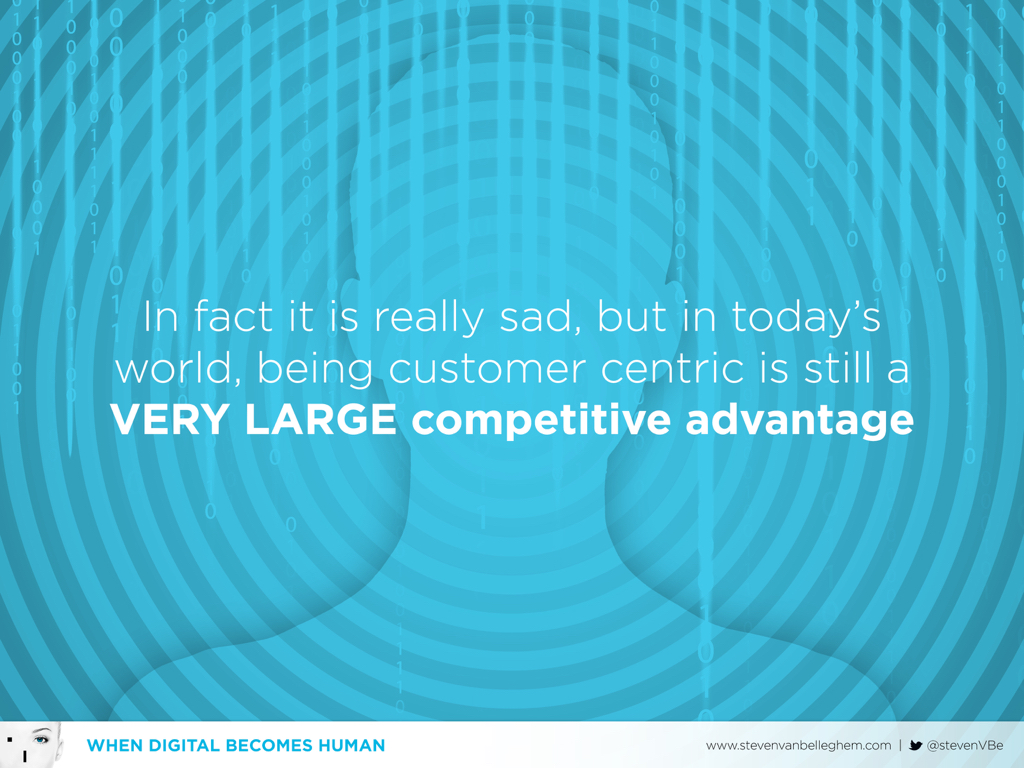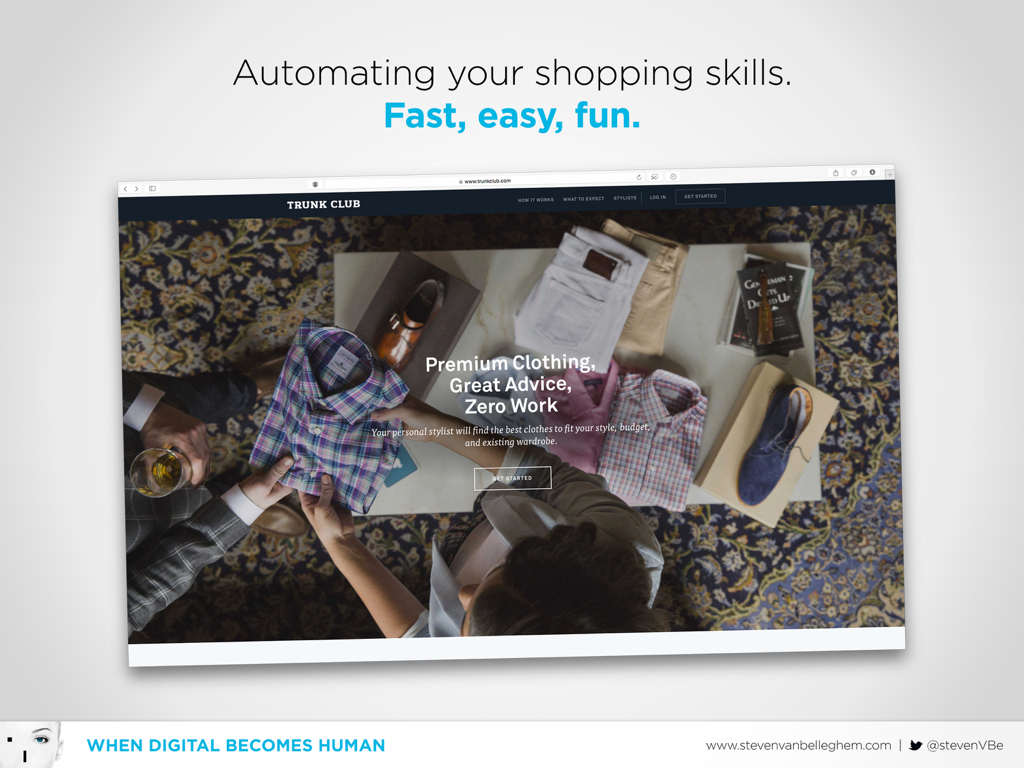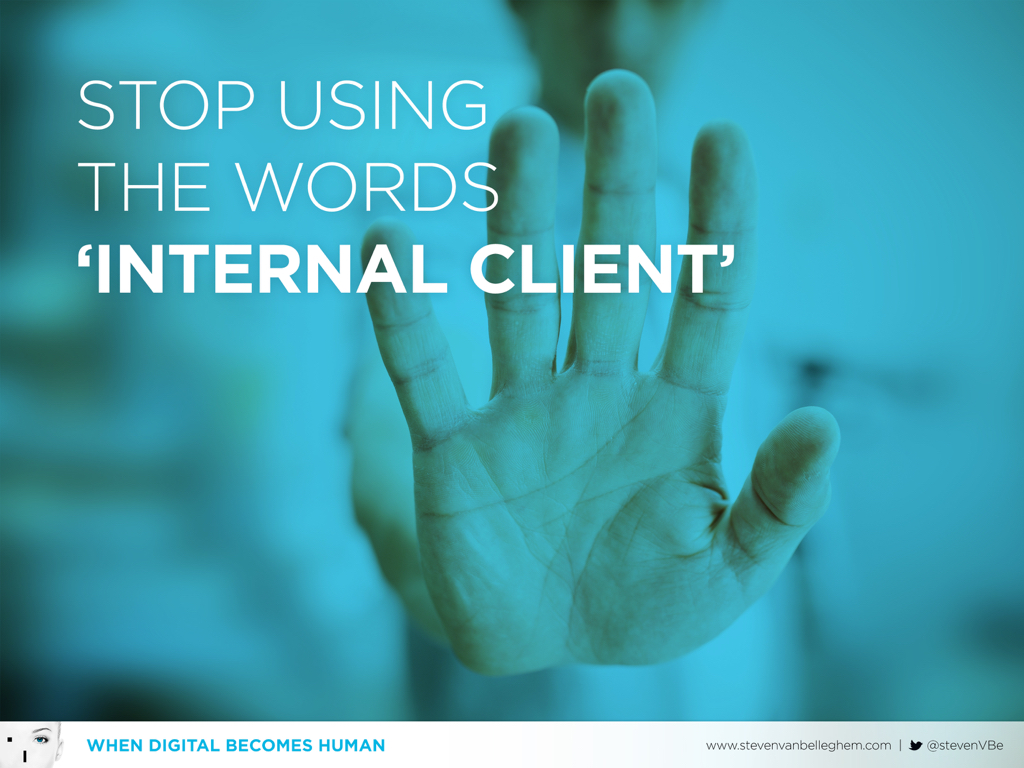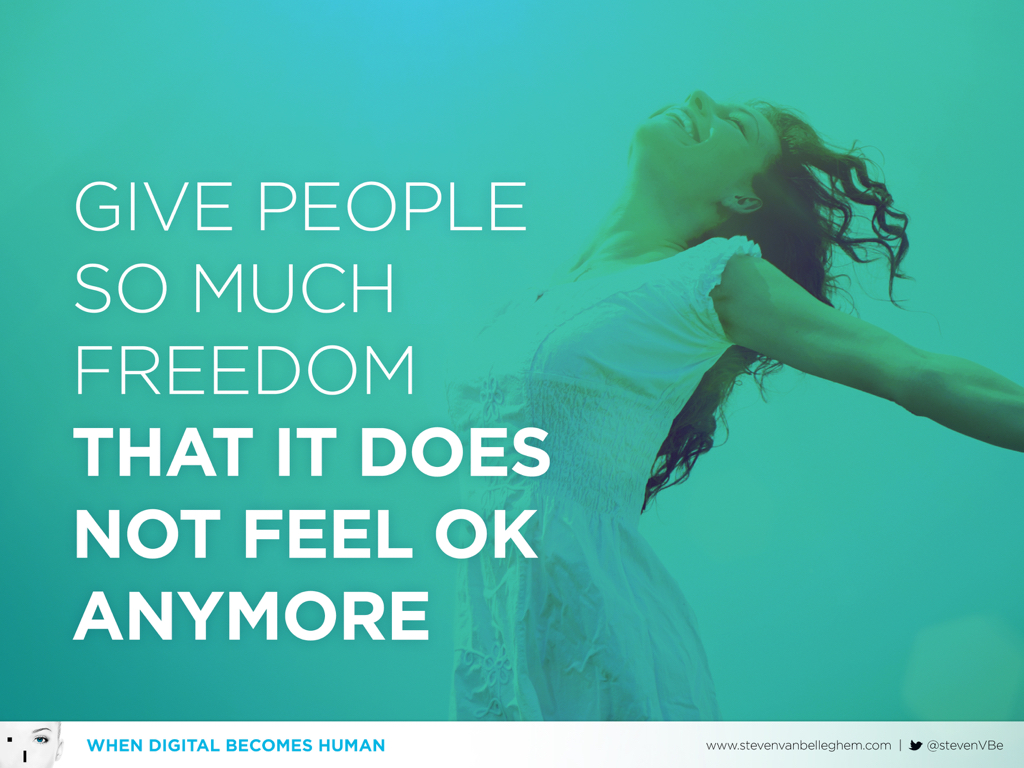Digital first = Customer first model

Customer first model
If you´d like to explore my customer first model in greater depth, be sure to take a look at this presentation on SlideShare, where you´ll find a wealth of details and many additional examples.
1. Details define extreme customer focus
Extreme customer focus is necessary. Although the word “extremism” sometimes has a negative connotation. After all, extremism in politics or religion often leads to evil consequences. In the customer relationship it´s about positive extremism. Why the need for extreme customer focus? Because many companies use the term ´customer focus´ in the wrong way. I don´t know any company that doesn´t say that it’s customer-focused. Yet only a handful of organizations really are so. 80% of CEOs find their company to be customer-focused, yet only 8% of the customers agree with that. Only an extreme focus on the customer actually backs up the words.
A McKinsey study demonstrated that the difference isn´t made in the classic channels or products, but precisely between the channels. Generally a company has its basic processes and products under control, but things go wrong in the details. Look at the details of the customer relationship and you can quickly suss out whether a company is in fact extremely customer-focused. You can see it in the way companies deal with complaints. You recognize extreme customer focus when a company is ready to recommend its competitor if the latter has a better solution for the customer. A restaurant that is all booked up and recommends good, similar restaurants to potential guests demonstrates extreme customer focus.
Q-Music, the successful Belgian radio station, is known for its spectacular actions for listeners. One time the station gave a house worth €250,000 to a lucky listener. The winner was in seventh heaven – which rapidly turned into building project hell, however. The construction company walked away from the job half-way through and the house wasn´t completed. The wonderful prize threatened to turn into a huge nightmare. Q-Music´s slogan is ´Q is good for you´. The Q team believes in this slogan and tries to put it into practice. Q-Music came up with a solution. The radio station paid €250,000 in cash onto the account of the winners so that they could buy a new house. This sounds self-evident, but in fact it´s highly exceptional. Most companies would probably have opted for a legal solution that would take a very long time, but which would hopefully save them from having to shell out any extra money. Instead, Q-Music put the listener first. That’s extreme customer focus.
It´s a valuable exercise to look for your own ´symbols of extremism´. Symbols of extremism are details by which you prove to the customer (and to yourself) that you really mean it. For example, it’s the quality of the food at Tomorrowland, the world´s best music festival. The way the Carglass employees vacuum the car’s carpets. Such symbols of extremism make the customer-focused attitude concrete. It is visible for the customer and serves as a guideline for the employees.
2. An adaptive business model: eat or be eaten
Dare to invest in a business model with which you attack yourself. Jef Bezos, CEO of Amazon, once sent a number of his top people into seclusion. Their mission: to work out a concept under which Amazon could be rendered superfluous. The idea had to be perfectly thought out so that Amazon could implement it itself. That´s how Amazon Prime developed. Prime is a streaming service. With it, Amazon customers no longer have to buy music, books or films – for a monthly fee they can simply make unlimited use of them. This service constitutes a frontal attack on Amazon´s basic business model. Yet they launched Prime anyway, because it´s a good idea, because the market is evolving in this direction, and because the risk was too great that someone else would do it.
Extreme customer focus goes hand in hand with an adaptive business model. Clinging to the existing way of doing things is the very definition of a dead end.
The telecom industry did this well with the rise of mobile telephony. The mobile phone has replaced the landline telephone. Most classic telecom players attacked themselves by betting everything on mobile. However, they’ve missed the train completely with online communication. Actually, the telecom industry should have launched services like Skype and What´s App. Most likely the ideas were out there, but they were never approved due to the potential loss of turnover on the existing market. By not doing it themselves, today it´s a bigger problem.
Disney is a fantastic brand, but the company has experience above all in the classic media world. The media sector has been under pressure for quite a while. Young people spend less time in front of the TV, while YouTube has become indispensable. Reacting to the increasing importance of YouTube, in March 2014 Disney purchased Makers Studios. Disney paid around 500 million dollars, with the option to increase the amount by a further 450 million if certain targets were attained. Makers Studios is one of the largest networks on YouTube. They have over 55,000 channels, accounting for around 5.5 billion views each month. Conventional TV networks can only dream of such figures. Via this channel Disney is once again succeeding in getting closer to its target group. Moreover, Disney wants to use their expertise to leverage the success of e.g. Mickey Mouse, Pixar and Star Wars on YouTube.
3. The Angry Bird check list: fast, easy and enjoyable
Angry Birds is one of the most successful mobile games in recent history. Over the past few years the different variants have been downloaded more than 2 billion times. The games are appreciated for their user-friendliness, their humor, their low price and naturally the sheer fun of playing them. From experience I know that a 2 year-old begins to discover the game. A 4 year-old is already an expert. I use Angry Birds as a symbol for the modern customer relationship. Consumers are looking for exactly what Angry Birds offers them: fast, easy and enjoyable solutions. Companies can ask themselves the question: to what extent do our customer interactions satisfy this Angry Bird checklist?
Trunk Club is a beautiful example of a company that fulfills the Angry Bird checklist. The company was founded in 2009. The target group are men who love clothes but don’t like shopping, and that would appear to be a pretty large group. By 2014 their team had already developed into a group of 300 employees. It works very simply. By clicking on photos of men wearing clothes in your style, their site gets an ever-better picture of your personal taste. After four screens they summarize your clothing style on the basis of 10 photos. If you agree, you can indicate what your budget is and how often clothes may be delivered. So for example you enter $500 per quarter. And that´s when the magic happens. Every quarter, a suitcase with clothing in your size and in your taste is delivered to your home. The clothes that you like you can keep. Items you don´t find suitable you simply send back. It´s a very quick, easy and enjoyable process.
An Angry Bird customer relationship involves not only online transactions. The customer expects all of the Angry Bird elements in the offline relationship as well. The increasing use of RFID (Radio Frequency Identification) is an example of how the offline customer relationship becomes faster, more efficient and more enjoyable. RFID is a technology for remotely storing and reading information. The best-known examples are the RFID chips contained in the wristbands for summer festivals. With these wristbands visitors can enter the festival area, and in many cases they even pay with it. Soon this technology will be woven into our clothing. If a customer comes to the cash register with 7 items of clothing to purchase, the cashier no longer has to scan in the 7 items. Thanks to the RFID chips, she immediately knows the total price. Moreover, the anti-theft security will also be switched off immediately. This will significantly increase the speed at the cash register. The products in department stores will be equipped with such technology as well. So customers no longer have to take their items out of the shopping cart and place them on the conveyor belt. The price for the entire shopping cart is calculated remotely in one second.
Technology is helping companies to do a better and better job of fulfilling the Angry Bird checklist, in both the online and the offline worlds. Applying the Angry Bird checklist is a combination of the right mindset with the use of new, smart technology.
4. The back office doesn´t exist! Everyone works for the end customer!
It´s a management classic: ´Customer focus is not the responsibility of a single specific department; it´s the attitude of an entire organization´. In today´s society, this is truer than it ever was. In the earlier customer relationship, everything could be nicely polished up with some good advertising and a few good ´visible´ employees. Via social media consumers are getting more insight into what goes on behind the scenes. The role of HR has therefore acquired a lot more impact, because a customer-focused back office starts with customer-focused employees. Due to the increasing importance of technology, the role of the IT department is more crucial than ever, but unfortunately there are often tensions between IT and the front-end employees. The back office obviously encompasses more than just HR and IT. Every department has its impact on the customer relationship: HR, IT, the financial teams, the product development staff… Without their help, one cannot succeed in being extremely customer-focused.
Many concepts have already been thought up for enabling back-end employees to work together on customer focus. The idea of working with an internal customer attitude is an oft-employed concept. In this way colleagues (the internal customer) get the same service as an end customer. The idea is well-intended, but it isn’t enough. Serving an internal customer does not deliver the same satisfaction as getting feedback from the end customer. A possible solution consists in linking the back office people with the end customer. Letting everyone receive the applause or the boos directly has an impact. The more intensely employees feel the feedback and the appreciation of the market, the greater their involvement. Each employee works to make an (external) customer happy, not (simply) an internal customer.
There are various ways to facilitate this. Installing screens with feedback on social media in all departments of the company is a quick win. Sharing e-mails conveying complaints and compliments with one another is a quick win. Letting a part of the management communicate directly with the end customer helps. Letting every employee work briefly on the customer service team has a great impact. There are very many ways to bring each employee closer to the end customer. Extreme customer focus is not about having the back office work better for the front office. Extreme customer focus is about abolishing the very idea of the back office. In an extremely customer-focused company, the back office concept doesn´t exist. Everyone is part of the front office.
5. The front office receives greater autonomy
American restaurants are fantastic on this point. If a waiter brings a drink too late, then he himself has the autonomy to offer it on the house. If he sees that someone didn´t find the meal delicious, he can himself decide not to charge the customer. In European restaurants, waiters generally have to ask for the owner’s OK for things like that. In America it works this way because the waiters are dependent on the tips from the customers. As a result, all processes are conceived as a function of customer satisfaction. Without the autonomy of the employees, this is a lot more difficult. The very slowness of the process (having to get an OK) already creates resentment. Autonomy of the front office employees is a blessing for both the customer and the employee.
Eneco, a rapidly-growing challenger on the Belgian energy market, believes in autonomy for its front office employees. At the beginning of 2014 they launched their flower power program for their helpdesk employees. Employees in the call center can henceforth decide on their own initiative to send people a small token of appreciation, such as a handwritten card or a beautiful bouquet of flowers. These tokens of appreciation are not only intended to help calm the waters in tense situations. They can just as well be sent out to an enthusiastic customer, or someone going through a personal drama (e.g. a death in the family). There are no concrete rules. The employee himself decides. The employee finds this fantastic, and customers get a good feeling from it.
The management does best to issue a single rule to go with the autonomy: “Always decide to the customer´s benefit. No discussion.” Managers and entrepreneurs who give their employees such a form of trust will get it back in spades. The controlling factor of requesting approval for small, day-to-day things merely slows down and frustrates an organization.
6. The forgotten barrier! Behavior follows reward
The final check to test a company on its extreme customer focus is the bonus and evaluation system. If a company claims customer focus but has a purely sales and financially-driven bonus system, one can doubt the degree of customer focus.
ZLM is a relatively small insurer in the Netherlands, a local player in Zeeland and Brabant. The company is an exception in the insurance world. Because they have highly enthusiastic customers. After a claim, customers give them an 8.4 on a 10-point scale concerning customer satisfaction. Their Net Promoter Score (NPS) varies between 39 and 43, figures that make them the best-scoring insurer in the Netherlands. 90% of the insurers on the Dutch market have a negative Net Promoter Score. ZLM unquestionably has the most satisfied customers in the insurance sector. Their CEO sees their secret in part in their compensation strategy. Employees are only evaluated on a customer´s satisfaction, not on financial parameters. “Do you know what the problem with financial targets is?” he asked me. I had to admit that I didn´t. Then followed a brilliant insight: “The problem with financial targets is that your employees will do everything they can to achieve them. And who is very often the victim of this? The customer!” The sceptic is already asking: so, does ZLM have any profit goals? Well, in their market they have the biggest market share. They are growing at an average rate of 8% per year, while the sector as a whole is rather stable. Furthermore, ZLM is – relatively considered – the most profitable company in the sector in the Netherlands. What an interesting paradox: the company without financial targets or evaluation system has the strongest growth and the greatest profitability in the sector.
Some management teams wonder why their organization doesn’t succeed in making the transition to extreme customer focus despite all the workshops and communication on this. Generally, the solution lies with the forgotten barrier: the evaluation and bonus system. Behavior follows reward.
Economist John Kay discussed this paradox in his book ´Obliquity´: the best way to reach a goal is indirectly. The most profitable companies don´t strive for profit, but for excellent functioning. Companies with the greatest focus on profit have the biggest chance of not achieving their goals. Fascinating!
Digital and Human
In other words, extreme customer focus in a digital world requires the combination of being good in the digital and in the human. Reinventing the business model and the Angry Bird checklist are typical facets where you have to score well on the digital level. Eliminating the internal customer, giving autonomy to the front office and thinking up a customer-focused bonus strategy are more human aspects. Both are necessary in order to win the hearts and the business of modern customers.
If you want me to tell you the philosophy of this model, check out this video:





